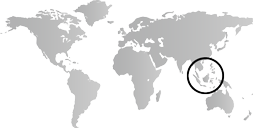Mainland Southeast Asia
Most of Southeast Asia continues to be colonized during the first half of the twentieth century: Vietnam, Cambodia, and Laos by the French; Malaysia and Myanmar (Burma) by the British; Indonesia by the Dutch; and the Philippines by the United States. Only Thailand remains independent. During World War II, the colonizing powers relax their grip on the region, and the Japanese encourage nascent independence movements to push for freedom. Though the Japanese occupation of Thailand, Vietnam, Burma, Malaysia, and Indonesia proves Japan’s propaganda to be self-serving, Southeast Asia is not prepared to resume the colonialist yoke when the war ends. Between 1945 and 1957, all of Southeast Asia gains its independence.
With independence, several Southeast Asian countries turn to democracy or constitutional monarchy. However, struggles between communist and anticommunist factions plague the region for much of the 1960s and ’70s. After the Vietnam War, Vietnam is united under communism and Laos also becomes communist. Cambodia suffers under the Khmer Rouge’s genocidal communism in the late seventies. Indonesia has a strong communist party, which is influential under its first president, Sukarno (1901–1970). However, the military purges thousands of suspected communists in 1965. As for Burma, the country enjoys almost fifteen years of democracy, before a military coup installs a repressive and highly isolationist government. Overall, Southeast Asia faces economic difficulties, social and ethnic unrest, and political struggles through much of the mid-twentieth century. By the 1980s, conditions have improved, but the “Asian financial crisis” in the late 1990s is a serious setback for the region.
In the early decades of the twentieth century, Southeast Asian art is highly influenced by European art. Realism, Impressionism, and Expressionism are the favored styles. Landscapes and scenes of daily life are highly romanticized, while naturalistic portraits exalt the region’s elite. Artists study in the West throughout the twentieth century, and embrace elements of Western modernism, particularly Cubism and abstraction. With the rise of nationalism, however, artists and critics in several countries turn to increasingly political subject matter, and, in some cases, begin to question their dependence on Western techniques and idioms. Often artists turn nostalgically to traditional and folk arts in the search for new, non-Western styles. Mid-century, the dominant debate in the arts is over the relationship between East and West: modernism is equated with Westernization and the erosion of indigenous values, while tradition is embraced in the search for authentic national idioms. Naturally, many artists and intellectuals are critical of these simplistic formulations. Giving a national character to modern art remains a concern, but by the 1980s and ’90s, artists are less anxious about Westernization. Borrowing freely from a wide range of sources, many artists succeed in creating imagery that is at once personal and worldly, savvy of global trends while rooted in local concerns.
The arts develop much more slowly in communist Southeast Asia, and under Burma’s repressive military regime. Under communism, artists in Vietnam and Laos practice Socialist Realism in the service of the state. Greater freedoms are given to artists in the 1980s, but neither country encourages a sense of the avant-garde in the arts. In Cambodia, the Khmer Rouge put a decisive end to the arts, along with all forms of intellectual life. Following their reign, however, the country begins to develop a vibrant cultural life. In Burma, there is still a very limited art scene.
Island Southeast Asia
Among Southeast Asia’s indigenous peoples, missionary activities continue to increase in scope and intensity, and by mid-century most groups have been converted to Christianity. This conversion often has a devastating effect on local sculptural traditions as people cease to create, and in some instances destroy, images of ancestors and supernatural beings, which conflict with their newly adopted Christian beliefs. The region’s textile traditions, however, continue to flourish, although weavers increasingly employ artificial dyes and other introduced materials.
Beginning in the 1970s, the broader Western interest in the art of the world’s indigenous peoples results in greater attention to and collecting of works from the indigenous cultures of Southeast Asia. Much of the region’s surviving sculpture and large numbers of textiles are acquired by dealers and collectors and enter Western museums and private collections.


